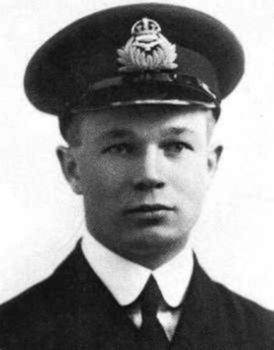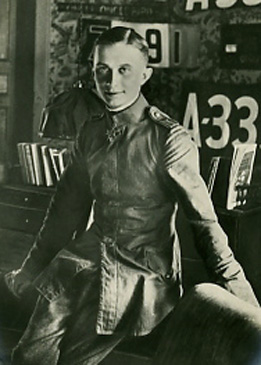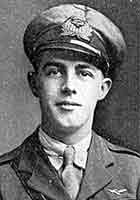Related Research Articles

Arthur Roy Brown, was a Canadian flying ace of the First World War, credited with ten aerial victories. The Royal Air Force officially credited Brown with shooting down Manfred von Richthofen, the "Red Baron", although historians, doctors, and ballistics experts consider it all but certain that Richthofen was actually killed by a machine gunner firing from the ground.

LeutnantKarl Allmenröder was a German World War I flying ace credited with 30 aerial victories. The medical student son of a preacher father was seasoned in the trenches as an 18-year-old artilleryman in the early days of the First World War, earning promotion via battlefield commission to Leutnant on 30 March 1915. After transferring to aviation and serving some time as an artillery spotter in two-seater reconnaissance airplanes, he transferred to flying fighter aircraft with Jagdstaffel 11 in November 1916. As Manfred von Richthofen's protege, Karl Allmenröder scored the first of his 30 confirmed victories on 16 February 1917. Flying a scarlet Albatros D.III trimmed out with white nose and elevators, Allmenröder would score a constant string of aerial victories until 26 June 1917, the day before his death. On 27 June 1917, Karl Allmenröder fell to his death near Zillebeke, Belgium. His posthumous legacy of patriotic courage would later be abused as propaganda by the Nazis.
Richard Pearman Minifie, was an Australian fighter pilot and flying ace of the First World War. Born in Victoria, he attended Melbourne Church of England Grammar School. Travelling to the United Kingdom, he enlisted in the Royal Naval Air Service in June 1916. Accepted for flight training, he completed his instruction in December and joined No. 1 (Naval) Squadron RNAS on the Western Front in January 1917, flying Sopwith Triplanes. He went on to score seventeen aerial victories on this type of machine throughout the year, becoming both the youngest Australian flying ace of the First World War and No. 1 (Naval) Squadron's highest-scoring ace on the Triplane. The unit re-equipped with the Sopwith Camel late in 1917, with Minifie going on to achieve a further four victories on the aircraft, raising his final tally to a score of twenty-one aircraft shot down.

OberleutnantKurt Robert Wilhelm Wolff PlM was one of Imperial Germany's highest-scoring fighter aces during World War I. The frail youthful orphan originally piloted bombers before being picked by Manfred von Richthofen to join Jagdstaffel 11 in the burgeoning Imperial German Air Service. Under the tutelage of Richthofen, Wolff would shoot down 33 enemy aircraft in four months, including 22 victims during the Royal Flying Corps' disastrous Bloody April, 1917. Wolff scored victories so rapidly he outran the Prussian awards system; although the Pour le Merite was customarily awarded after a fighter ace's 20th victory, Wolff's was not received until after his 29th.
John Inglis Gilmour, was a British flying ace of the First World War. He was the highest scoring Scotsman in the Royal Flying Corps, with 39 victories.
John Lightfoot Trollope, was a British First World War flying ace, credited with 18 aerial victories, including seven in one day, the first British pilot to do so.

Major Charles Dawson Booker was an English World War I fighter ace credited with 29 victories. He was promoted to high rank while relatively young as a result of his gallantry and unswerving dedication to his country.
Second Lieutenant Orlando Clive Bridgeman was a World War I flying ace credited with five aerial victories.
Captain Sydney Philip Smith, was a British First World War flying ace, who was credited with five aerial victories, before being shot down and killed, the 76th victory of Manfred von Richthofen.
Captain Thomas Sydney Sharpe was a British World War I flying ace credited with six aerial victories.
Lieutenant Thomas Henry Barkell (1892–1945) was an Australian flying ace of the First World War, credited with seven aerial victories.
Captain Henry Hollingdrake Maddocks was a British World War I flying ace credited with seven aerial victories.
Flight Lieutenant Henry Michael Moody was a British World War I flying ace credited with eight aerial victories. His sixth triumph was over German ace Alwin Thurm. He served in the Royal Air Force post-war, until killed in a flying accident in 1931.
Oliver William Redgate, was a British flying ace of the First World War, credited with 16 aerial victories.
Captain Harold Thomas Mellings was a British World War I flying ace credited with 15 aerial victories.
Captain Kenneth Barbour Montgomery was an English World War I flying ace officially credited with 12 aerial victories. After downing four German fighters while piloting a two-seater aircraft, he switched to a single-seater fighter for his last eight victories.
Flight Commander Guy William Price was an Irish Royal Naval Air Service flying ace during World War I, having 12 confirmed aerial victories. He was awarded the Distinguished Service Cross twice within a 22-day period.

Flight Sub-Lieutenant Harold Day was a Welsh World War I flying ace credited with 11 confirmed aerial victories.
Captain Francis Mansel Kitto was a Welsh-born flying ace credited with nine official aerial victories during World War I.
Lieutenant Harold Francis Stackard was a First World War British flying ace credited with fifteen aerial victories. In addition to serving as a pilot during the war, he was a Royal Air Force instructor.